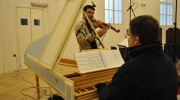“Ufficio delle Tenebre” The Musical Celebration of the Rite of Mattutini of Maundy Thursday

Related projects

- Domenico Scarlatti Viola d’Amore Sonatas, a New Musicological Discovery – Recording of a CD (Mother project)
- Viola d’Amore Sola: Music for solo viola d’amore – Recording of a Cd
- Recording of a Cd of Music for Viola d’Amore by Robert Lach (Wien 1874 – Mondsee, Salzburg 1958)
- Bassifondi Musicali, a Baroque Popular Music Concert
- ALIAS, Contemporary Music for an Early Instrument, the Viola d'Amore. Recording of a CD
Project location: Italy, Rome
Project start date: December 2012 -
Project end date: March 2013
Project number: 2012-094
Beneficiary: Associazione Culturale Musicale Musicangelica
Timeline of the present activity report: From January 2013 to March 2013
From the beginning the project was focused on the dialogue between great Italian ancient sacred music heritage and Catholic liturgy. Following a change to the initial shape of the project, its intent became that of hosting a "spiritual concert". A “Spiritual Concert” although it takes its name from the word “concerto” is not a “concert”. It has not its character and meaning. This is an ancient spiritual practice that combines prayer and music: the public performance of sacred or spiritual music is carried out in an atmosphere of reflection and prayer. The spiritual concert was held on the 27 of March 2013, within the church of SS. Nereo and Achilleo in Rome. This is a very ancient church: its construction started in the 4th century B.C. The church was also called “Titulus Fasciolae” because it was built in the place where St. Peter lost a foot bandage (fasciola in latin) on his way to escape from the Mamertine Prison; the dedication to the two Saints, both soldiers and martyrs, Nereus and Achilleus is dated in the sixth century. A great restoration was made in 1600 by Cardinal Cesare Baronio from the Congregazione dell’Oratorio, and the church took its present aspect. A “musical celebration” of the Mattutino of Holy Thursday, as the project title says, refers directly to the music that was performed during the celebration of the rite of that Mattutino. More precisely the project wants to recreate the exact musical scheme of the first Mattutino of the first Notturno of that day. This rite plans the reading of three “lectiones” of the Word of God: each “lectio” of the first Mattutino contains the reading of the first Lamentation of Jeremiah and of three Responsoria. Important composers from the Renaissance to the modern era set in music these biblical texts.
The first phase of the project was to find suitable music for the Mattutino: the field of research was the great roman tradition of music of the XVII century, descended from the renaissance tradition. In particular, several manuscripts held in a roman ecclesiastic musical archive were considered. These ancient papers dating from beginning of the XVIII century preserve a complete musical setting of the “Lamentations of Jeremiah” scored for soprano, two violins and basso continuo. Some of the Lamentations are set to music by Alessandro Scarlatti (1660 – 1725), master of the roman musical school between the XVII and XVIII centuries. During the musicological study of this roman musical archive a second Lamentation by an anonymous composer stored together with those by Scarlatti was discovered; this music is also to be attributed with some probability to the famous composer. This piece, of an outstanding beauty, was written for the Holy Thursday Mattutino and fits in perfectly with the project's objectives. An ensemble of five musicians was created to perform this music: Soprano voice, two violins, organ and theorbo. The manuscripts were interpreted, re-discovered, studied and transcribed in modern notation by the musicians in order to make a modern performance possible. The performance followed as much as possible the criteria of a "historically informed" execution, so as to recreate a sound as close to the ancient concept and reality as possible. Also the musical instruments meet the standards of the old instruments: gut strings, historical bows; an added value to the project was the possibility to use an ancient positive organ attributed to Johannes Conrad Werle and built around 1760 preserved in the SS. Nereo and Achilleo church. To the Scarlatti Lamentations were added the Responsoria by Lorenzo Perosi, published in 1899 by the author. D.Lorenzo Perosi is the most famous composer of church music of the modern era and his Responsori for the Holy Week written for three voices without accompaniment are a unique example of the merging of great sacred music tradition and modern innovation. The combination of Scarlatti and Perosi music together with Gregorian Chant created a very interesting effect. Three male singers performed the Perosi Responsori and they were hidden in the apse of the church behind the ambon. The resulting effect was a kind of “celestial” dialogue between this Lamentation and the other that instead was performed from a visible place
The scheme was:
Antifona (Gregoriano)
Zelus domus tuae
LECTIO PRIMA
Anonimo (Roma, inizio XVIII sec., Alessandro Scarlatti ?)
Lectio prima die Mercurij a canto solo con violini
Incipit Lamentatio Jeremiae Prophetae
D. Lorenzo Perosi (1872 - 1956)
Responsorio primo a tre voci
In monte Oliveti
Gregorian Chant and Falsobordone
Vau et egressus est
LECTIO SECUNDA
D. Lorenzo Perosi
Responsorio secondo a tre voci
Tristis est anima mea
LECTIO TERTIA
Alessandro Scarlatti (Palermo, 1660 - Napoli, 1725)
Lettione del Mercordì Santo
Jod. Manum suam misit hostis
D.Lorenzo Perosi
Responsorio terzo
Ecce vidimus eum



